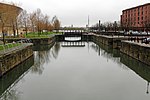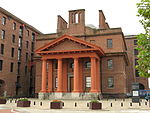The Beatles Story

The Beatles Story is a museum in Liverpool about the Beatles and their history. It is located on the historical Royal Albert Dock, and is owned by Mersey Ferries, part of Merseytravel. The Beatles Story contains recreations of The Casbah Coffee Club, The Cavern Club and Abbey Road Studios among other historical Beatles items, such as John Lennon's spectacles, George Harrison's first guitar and a detailed history about the British Invasion and the solo careers of every Beatle. The museum was also recognised as one of the best tourist attractions of the United Kingdom in 2015. The exhibition was preceded by the Cavern Mecca (1981-1984) and Beatles City (1984-1986).
Excerpt from the Wikipedia article The Beatles Story (License: CC BY-SA 3.0, Authors, Images).The Beatles Story
Gower Street, Liverpool Ropewalks
Geographical coordinates (GPS) Address Nearby Places Show on map
Geographical coordinates (GPS)
| Latitude | Longitude |
|---|---|
| N 53.399 ° | E -2.992 ° |
Address
Britannia Pavillion
Gower Street
L3 4AS Liverpool, Ropewalks
England, United Kingdom
Open on Google Maps








